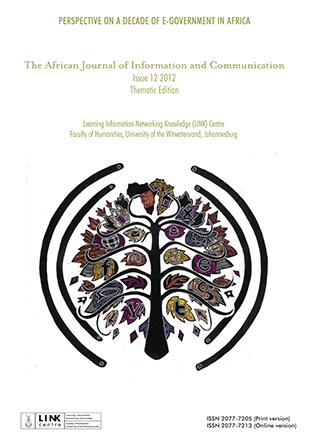Telecentre Approaches in Cameroon and Kenya Illuminated Using Behavioural Archaeology
DOI:
https://doi.org/10.23962/10539/19708Keywords:
behavioural archaeology, telecentres, Cameroon, Kenya, electronic communications, resource-poor environmentsAbstract
Throughout the last decade, telecentres have provided access to electronic communications as a supporting ICT infrastructure for community, economic, educational and social development. While the origins of telecentres can be traced to Europe's telecottage and community technology centres in the United States in the 1980s, telecentres have taken varying forms and approaches. This article illuminates approaches used by telecentre projects in Kenya and Cameroon, using behavioural archaeology. Literature stresses that behavioural archaeology refers to understanding the artefact as a tool in human activity and technology as the embodiment of human activity in the artefact. Application of behavioural archaeology to telecentres sheds light on the nature of technology use leading to particular results or societal outcomes. Using a qualitative methodology, managers, local contractors and technicians at local telecentres were interviewed. The results show differing approaches to the purpose and design of telecentres. In Kenya, the focus is on e-government services, while in Cameroon it is on conflict solving among different societal groups. In its use of behavioural archaeology, this article adds a new perspective on the challenges of making ICT and electronic media available in resource-poor environments.
References
Abbott, J. & Yoong, P. (2005). The stages of telecentre development: the case of the Kapiti telecentre. Technovation, Volume 25, No. 4, pp. 421-431. https://doi.org/10.1016/j.technovation.2003.11.001
Agbeja, O. & Salawu, R. (2007). Development in Sub-Saharan Africa: Overcoming the digital divide. Information Technology Journal Volume 16, No. 2, pp. 166-173.
Aji, Z., Mohd Yusof, S., Sheik Osman, W. & Yusop, N. (2010). A conceptual model for psychological empowerment of telecentre users. Computer and Information Science, Volume 3, No. 3, pp. 71-79. https://doi.org/10.5539/cis.v3n3p71
Bird, D. & O’Connell, J. (2006). Behavioral ecology and archaeology. Journal of Archaeological Research, Volume 14, No. 2, pp. 143-188. https://doi.org/10.1007/s10814-006-9004-0
Bleed, P. (1997). Content as variability, result as selection: Toward a behavioural definition of technology. American Anthropological Association, Volume 7, No. 1, pp. 95-104. https://doi.org/10.1007/BF02428071
Crellin, I. (1994). The Australian telecentre program: A new approach to technology transfer and rural community development. 22nd International Conference of Agricultural Economists , Harare, Zimbabwe, 22-29 August, p. 14.
Ellen, D. (2003). Telecentres and the provision of community based access to electronic information in everyday life in the UK. Information Research, Volume 8, No. 2, available at: http://informationr.net/ir/8-2/paper146.html.
Gaiani, S., Hansson, H., Meegammana, N. & Mozelius, P. (2009). Critical issues for e-learning telecentres in Sri Lanka and India. ICDE World Conference on Open Learning and Distance Education, Maastricht, Netherlands.
Gómez Díaz, M. & Sandoval-Almazán, R. (2009). Tecnologías de la información y aprendizaje organizacional en telecentros. Revista Eletrônica De Sistemas De Informação, Volume 8, No. 2, pp. 1-22. https://doi.org/10.5329/RESI.2009.0802001
Hallberg, D., Kulecho, M., Kulecho, A. & Okoth, L. (2011). Case studies of Kenyan digital villages with a focus on women and girls. Journal of Language, Technology & Entrepreneurship in Africa, Volume 3, No. 8, pp. 255-273.
Hodder, I. (2001). Archaeological theory today. Polity, Cambridge.
Ibrahim, H., Yasin, A. & Dahalin, Z. (2010). Financial sustainability Issues in Malaysia’s telecentres. Computer and Information Science Volume 3, No. 2, pp. 235-240. https://doi.org/10.5539/cis.v3n2p235
Jensen, M. & Esterhuysen, A. (2001). The community telecentre cookbook for Africa, Recipes for self-sustainability: How to establish a multi-purpose community telecentre in Africa. United Nations Educational Scientific and Cultural Organization, Paris.
Government of Kenya (2007). Kenya Vision 2030. The popular version. Government of Kenya, Nairobi.
Kenya ICT Board. (2010). About Kenya ICT Board,. retreived 20 November 2010 from http://www.ict.go.ke/index.php?option=com_content&view=article&id=160&Itemid=182.
Larson, R. & Murray, M. (2008). Distance learning as a tool for poverty reduction and economic development: A focus on China and Mexico. Journal of Science Education and Technology, Volume 17, No. 2, pp. 175-196. https://doi.org/10.1007/s10956-007-9049-5
Naik, G. (2011). Designing a sustainable business model for e-governance embedded rural telecentres (EGERT) in India. IIMB Management Review, Volume 23, No. 2, pp. 110-121. https://doi.org/10.1016/j.iimb.2011.02.004
Ramos, A., Nangit, G., Ranga, A. & Triñona, J. (2007). ICT-enabled distance education in community development in the Philippines. Distance Education, Volume 28, No. 2, pp. 213-229. https://doi.org/10.1080/01587910701439274
Rogers, E. & Shukla, P. (2001). The role of telecenters in development communication and the digital divide. Journal of Development Communication: Special Issue on Telecenters, Volume 12, No.2, pp. 1-6.
Schiffer, M. (2002). Studying technological differentiation: The case of 18th-century electrical technology. American Anthropologist, Volume 104, No. 4, pp. 1148-1161. https://doi.org/10.1525/aa.2002.104.4.1148
Sharma, M. (2005). Information and communication technology for poverty reduction. The Turkish Online Journal of Distance Education, Volume 6, No. 2, pp. 16-23.
Terry, A. & Gomez, R. (2010). Gender and public access computing: An international perspective. The Electronic Journal of Information Systems in Developing Countries, Volume 43, No. 5, pp. 1-17. https://doi.org/10.1002/j.1681-4835.2010.tb00312.x
Downloads
Published
Issue
Section
License
Copyright (c) 2012 https://creativecommons.org/licenses/by/4.0

This work is licensed under a Creative Commons Attribution 4.0 International License.
How to Cite
- Abstract 159
- pdf 120


.png)